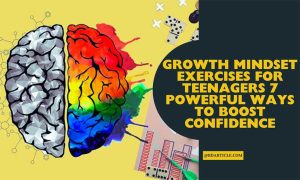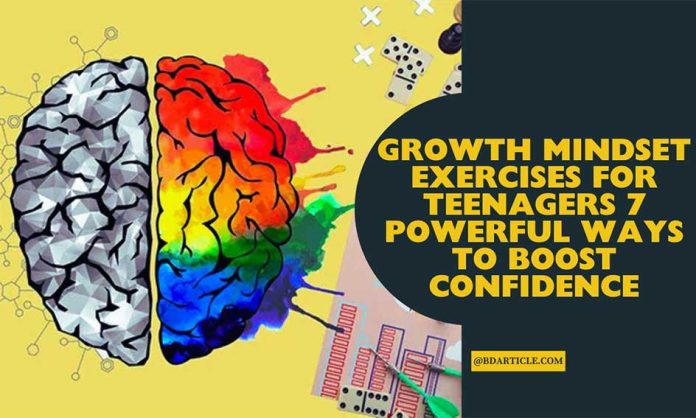Growth mindset exercises for teenagers are essential tools that help young individuals develop resilience, confidence, and a positive approach to challenges. Adolescence is a critical time when teens form beliefs about their abilities and potential. By fostering a growth mindset, teenagers learn to view setbacks as opportunities for growth rather than failures. This article explores seven powerful ways to boost confidence through growth mindset activities tailored specifically for teens. These strategies not only empower young minds but also lay the foundation for lifelong learning and success.

Embrace Challenges with Open Arms
One of the most effective growth mindset exercises for teenagers involves teaching them to embrace challenges instead of avoiding them. Many teens feel discouraged when faced with difficult tasks, fearing failure or judgment. However, reframing challenges as stepping stones to success can transform their perspective. Encourage teens to take on projects slightly outside their comfort zone, whether it’s joining a new club, trying out for a sports team, or tackling a challenging school assignment.
Activities like these are often included in growth mindset activities PDFs designed for students. These resources provide practical exercises such as journaling about obstacles they’ve overcome or creating vision boards to visualize goals. By consistently practising this mindset shift, teenagers build confidence in their ability to handle adversity and grow stronger from every experience.
Cultivate a Love for Learning
A love for learning is at the heart of a growth mindset. Growth mindset activities for high school PDF materials frequently emphasize the importance of curiosity and exploration. Teens should be encouraged to see education not as a chore but as an exciting journey of discovery. For example, introducing self-directed learning strategies can spark enthusiasm for acquiring new skills.
Unlock 7 Powerful Self-Directed Learning Strategies by encouraging teens to set personal learning goals. Whether it’s mastering a musical instrument, coding, or exploring a foreign language, self-directed projects foster independence and intrinsic motivation. Parents and educators can support this process by providing access to resources like online courses, books, or workshops. When teens take ownership of their learning, they develop a sense of accomplishment that boosts their confidence.
Reframe Failure as Feedback
Failure is often perceived negatively, especially among teenagers who may feel immense pressure to succeed. Growth mindset exercises for teenagers focus on reframing failure as valuable feedback rather than a reflection of inadequacy. Discuss real-life examples of successful people who encountered numerous failures before achieving greatness—stories like those of Thomas Edison or J.K. Rowling inspire teens to persevere.
Interactive activities, such as role-playing scenarios in which teens analyze mistakes and identify lessons learned, reinforce this concept. A growth mindset for teens also includes group discussions in which participants share their own experiences with failure and how they grew from it. These conversations normalize setbacks and highlight the importance of persistence in overcoming obstacles.
Practice Positive Self-Talk
The way teenagers speak to themselves has a profound impact on their confidence and outlook. Negative self-talk can sabotage efforts and reinforce limiting beliefs, while positive affirmations promote resilience and optimism. Growth mindset activities for students often incorporate exercises that encourage mindful self-talk.
For instance, ask teens to write down three positive affirmations each morning, such as “I am capable of solving problems” or “Every challenge helps me grow.” Over time, these affirmations become ingrained in their thought patterns, replacing doubt with determination. Additionally, mindfulness practices like meditation or gratitude journaling complement these exercises by fostering emotional regulation and self-awareness.
Set SMART Goals for Success
Goal-setting is another cornerstone of growth mindset exercises for teenagers. Teaching teens to set Specific, Measurable, Achievable, Relevant, and Time-bound (SMART) goals provides clarity and direction. Without clear objectives, teens may struggle to stay motivated or measure progress effectively.
Growth mindset activities PDFs include activities such as creating a step-by-step action plan for achieving a goal. For example, if a teen wants to improve their grades, they might break this goal into smaller tasks like completing homework on time, attending tutoring sessions, or studying for 30 minutes daily. Celebrating small victories along the way reinforces the idea that effort leads to results, boosting confidence over time.
Surround Yourself with Supportive Influences
The environment plays a significant role in shaping a teenager’s mindset. A growth mindset for young adults emphasizes the importance of surrounding oneself with supportive influences—friends, family members, teachers, or mentors who believe in one’s potential. Encourage teens to seek out relationships that uplift and inspire them.
Group activities, such as peer mentoring programs or community service projects, connect teens with like-minded individuals who share similar values and aspirations. These interactions create a sense of belonging and accountability, motivating teens to push beyond their limits. Growth mindset activities for adults can also serve as inspiration, showing teens how older role models apply these principles in their lives.
Reflect and Celebrate Progress
Reflection is a powerful tool for reinforcing a growth mindset. Regularly taking time to reflect on achievements, no matter how small, helps teens recognize their progress and build confidence. Growth mindset exercises for teenagers often include guided reflection sessions where teens answer questions like “What did I learn this week?” or “How have I grown since last month?”
Celebrating milestones is equally important. Whether it’s acknowledging improved performance in a sport or mastering a new skill, recognizing effort and improvement fosters a sense of pride. Activities like creating a “success jar,” where teens write down accomplishments and revisit them periodically, make reflection fun and meaningful.
Unlock Potential Through Consistent Practice
Building a growth mindset requires consistent practice and reinforcement. Growth mindset activities for students and teens should be integrated into daily routines to ensure lasting impact. Parents and educators can play a pivotal role by modelling a growth mindset themselves and encouraging teens to adopt similar habits.
Resources like growth mindset activities PDFs offer structured exercises that simplify implementation. From visualization techniques to collaborative Problem-solving Games, these activities cater to diverse learning styles and preferences. By making growth mindset exercises a regular part of life, teens internalize the belief that intelligence and abilities can be developed through dedication and hard work.
Inspire Confidence in Every Step
Growth mindset exercises for teenagers equip young individuals with the tools they need to face life’s challenges with courage and determination. By embracing challenges, cultivating a love for learning, reframing failure, practising positive self-talk, setting SMART goals, surrounding themselves with supportive influences, and reflecting on progress, teens unlock their full potential.
These strategies not only boost confidence but also prepare teenagers for future success in academics, careers, and personal relationships. With access to resources like growth mindset activities for high school PDFs and guidance from Caring Adults, teens can navigate adolescence with resilience and optimism. Start implementing these exercises today, and watch as teenagers transform into confident, empowered young adults ready to conquer the world.
#Growth_Mindset_Exercises_for_Teenagers #Growth_mindset_activities_PDF #Growth_mindset_activities_for_high_school_PDF

